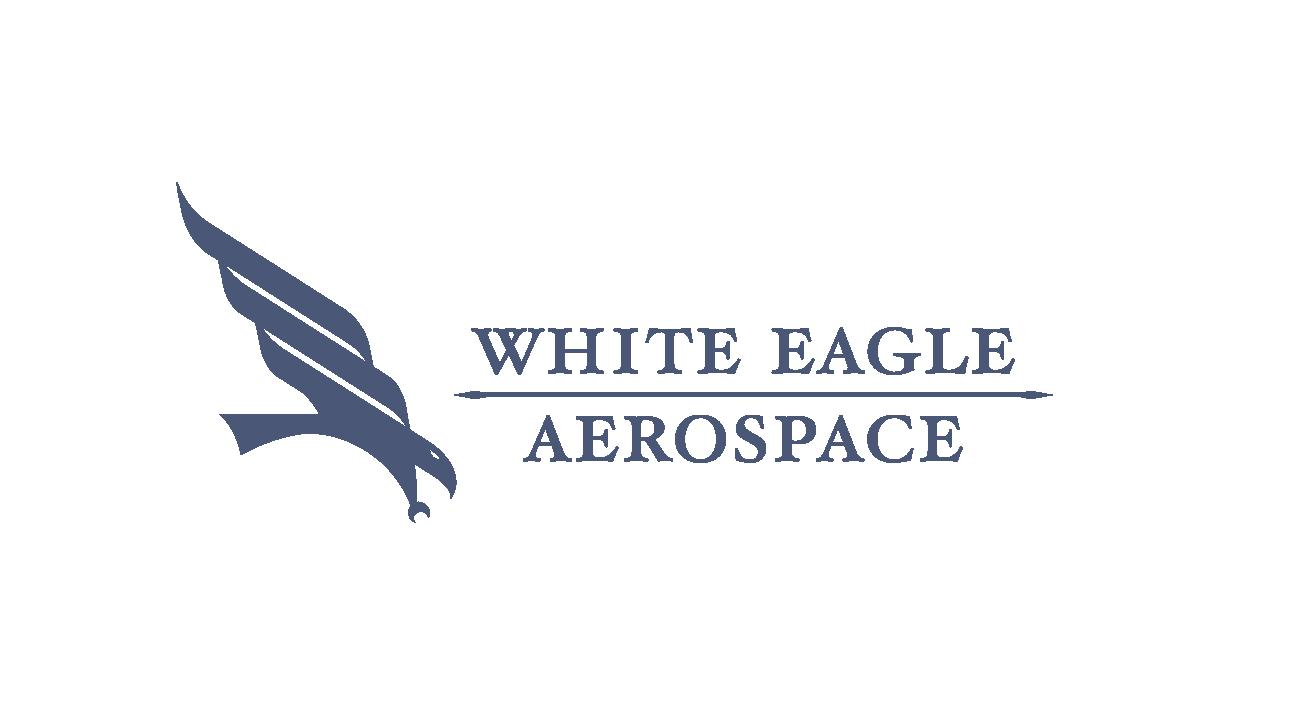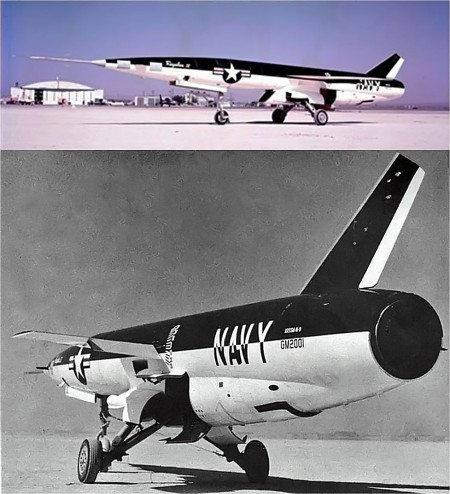
Fifty-seven years ago this week, the United States Navy successfully conducted the first flight test of the Chance Vought Regulus II cruise missile. This initial test departed from and recovered to Rogers Dry Lake at Edwards Air Force Base, California.
The Regulus II was designed as the supersonic follow-on to the Navy’s Regulus I ship-launched cruise missile. Utilizing an inertial reference system, the Regulus II was autonomously guided to the target. This represented a great improvement over Regulus I which employed a more primitive radio command guidance system.
Like its Regulus I forebear, Regulus II featured an airplane-like external airframe configuration and cruised under turbojet power. The vehicle was rocket-launched to the turbojet takeover speed (300 knots) using the Zero-Length Launch (ZLL) concept. The single rocket booster generated 115,000 lbs of thrust for 4 seconds and was jettisoned following burnout.
The Regulus II missile engineering and development effort saw the missile built in three (3) airframe blocks. The flight test version was designated as XRSSM-N-9 and included seven (7) airframes (GM-2001 to GM-2007). The fleet training variant was designated as XRSSM-N-9A, of which twenty-nine (29) were built (GM-2008 to GM-2036).
The Regulus II tactical missile, designated XSSM-N-9, included thirty-eight (38) airframes (GM-3001 to GM-3038). It measured 67 feet in length and featured a wingspan of 20.75 feet. Gross Take-Off Weight (GTOW) and empty weight were 21,300 lbs and 11,690 lbs, respectively. Power was provided by a General Electric J79 afterburing turbojet.
As originally designed, Regulus II was intended to cruise 1,000 nm at Mach 0.94 and an altitude of 32,000 feet. This range fell to 600 nm at a cruise altitude of 5,000 feet. For a supersonic cruise at Mach 2 and 65,000 feet, the vehicle had design range of 635 nm.
Initial flight testing of the Regulus II missile did not use the rocket booster. Rather, the vehicle became airborne via a normal runway take-off. The missile was remotely controlled by a pilot flying alongside in a two-place control aircraft. In this case, the aircraft was a TV-2D; a modified version of the Lockheed T-33. The front-seater flew the Regulus II while the back-seater flew the control airplane. Chase support was provided by Douglas F4D Skyray and Vought F8U Crusader aircraft.
Airframe GM-2001 made the first test flight of a Regulus II vehicle at Edwards Air Force Base, California on Tuesday, 29 May 1956. The first XRSSM-N-9 departed Rogers Dry Lake at 14:11 UTC following a take-off roll of slightly over 12,000 feet. The missile quickly accelerated to 356 knots as it climbed to an altitude of nearly 11,000 feet. Amazingly, all major missile systems performed nominally during the nearly 33-minute test hop and GM-2001 landed safely back on the dry lake bed.
The Navy would go on to conduct forty-seven (47) more Regulus II flight tests through November 1958. These tests were successful in the main and the Regulus II system performed well overall. However, the emergence of the contemporaneous and superior UGM-27 Polaris Submarine-Launched Ballistic Missile (SLBM) rendered the Regulus II missile obsolete. As a result, the Navy cancelled the Regulus II Program in December 1958.
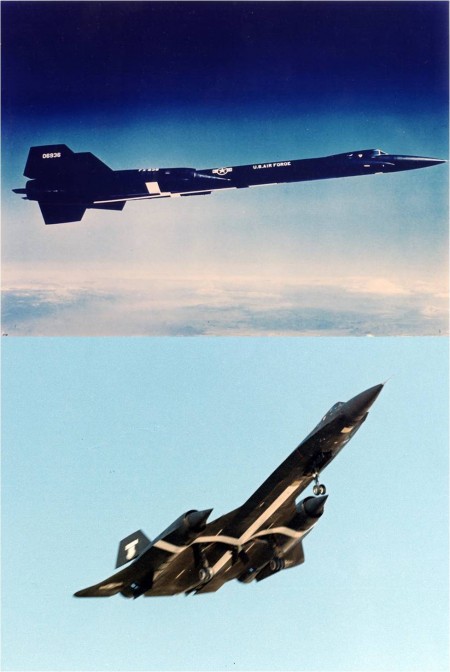
Forty-eight years ago this month, the USAF/Lockheed YF-12A set a bevy of world speed and altitude peformance records. A pair of aircraft and a team of five USAF aircrew flew these missions which originated out of Edwards Air Force Base, California.
The YF-12A was the interceptor variant of the vaunted Lockheed A-12 Mach 3+ aircraft. Armed with a quartet of Hughes AIM-47A air-to-air missiles, the YF-12A’s mission would be to intercept and destroy incoming Soviet bombers. Lockheed proposed the A-12 variant as a cost-effective replacement for the defunct North American XF-108 Rapier.
The YF-12A differed from the A-12 in that a second crew station was added for the AIM-47A Weapons Systems Officer (WSO). The WSO operated the powerful Hughes AN/ASG-18 fire control radar which had a range on the order of 500 miles. The YF-12A’s forebody chines were truncated back of the axisymmetric nose to accommodate the radar system. Infrared (IR) sensors were installed on the leading edges of the shortened chines.
The Hughes AIM-47A missile measured 12.5 feet in length and 13.5 inches in diameter. Maximum range of the 800-pound missile was in excess of 100 miles. While the type’s intended maximum Mach number was 6, propulsion system development problems limited the demonstrated maximum Mach number to 4. About eighty (80) AIM-47A missiles were produced. Seven (7) of these rounds were test fired in flight. All but one (1) was successful.
Lockheed converted a trio of A-12 aircraft to the YF-12A configuration. The YF-12A aircraft were assigned serial numbers 60-6934 (Ship 1), 60-6935 (Ship 2) and 60-6936 (Ship 3). Ship 1 made the maiden YF-12A flight from Groom Lake, Nevada on Wednesday, 07 August 1963 with James D. Eastham at the controls.
On Saturday, 01 May 1965, YF-12A aircraft 60-6934 and 60-6936 were flown by a quintet of USAF aircrew in an impressive demonstration of the interceptor’s altitude and speed performance. These missions were conducted by the Air Force Flight Test Center (AFFTC) at Edwards Air Force Base, California. Specifically, the following FAI-certified Class C Group III absolute performance records were established on that day:
Sustained Altitude (Absolute): 80,258 feet
Aircraft: YF-12A, Ship 1 (Serial Number 60-6934)
Aircrew: Col Robert L. Stephens/Lt Col Daniel Andre
15/25 km Closed-Circuit (Absolute): 2,070.102 mph
Aircraft: YF-12A, Ship 3 (Serial Number 60-6936)
Aircrew: Col Robert L. Stephens/Lt Col Daniel Andre
500 km Closed-Circuit (Class C): 1,643.042 mph
Aircraft: YF-12A, Ship 3 (Serial Number 60-6936)
Aircrew: Maj Walter F. Daniel/Maj Noel T. Warner
1,000 km Closed-Circuit, No Payload: 1,688.891 mph
Aircraft: YF-12A, Ship 3 (Serial Number 60-6936)
Aircrew: Maj Walter F. Daniel/Capt James P. Cooney
1,000 km Closed-Circuit, 1,000 kg Load (Absolute): 1,688.891 mph
Aircraft: YF-12A, Ship 3 (Serial Number 60-6936)
Aircrew: Maj Walter F. Daniel/Capt James P. Cooney
1,000 km Closed-Circuit, 2,000 kg Load (Class C): 1,688.891 mph
Aircraft: YF-12A, Ship 3 (Serial Number 60-6936)
Aircrew: Maj Walter F. Daniel/Capt James P. Cooney
USAF liked the YF-12A’s demonstrated performance capabilities. Thus, on Friday, 14 May 1965, the service ordered ninety-three (93) units of the production YF-12A aircraft known as the F-12B. Congress approved the order and allotted $90M to get production going. Unfortunately, United States Secretary of Defense Robert S. McNamara nixed the deal and cancelled the production of the F-12B.
Following the F-12B cancellation, YF-12A flight testing by USAF continued through 1969. One aircraft was lost along the way. On Thursday, 14 August 1966, Ship 1 was severely damaged in a landing incident at Edwards AFB and never flew again. Fortunately, the crew escaped with their lives.
In December of 1969, NASA initiated a flight research effort using YF-12A Ship 2 and Ship 3. Over the next ten (10) years a wealth of aerodynamic, aero heating, structural and propulsion flight research data were acquired using these unique high-speed assets. A great benefit in this regard was the type’s ability to sustain Mach 3+ flight conditions for periods up to 15 minutes per mission.
YF-12A Ship 3 was lost on Thursday, 24 June 1971 when an inflight fire started due to a failed fuel line in the right-hand J58 turbo-ramjet engine. The USAF crew of pilot Lt Col Ronald J. Layton and WSO Maj William A. Curtis attempted to recover the aircraft to Edwards AFB. However, the fire quickly spread and forced the crew to abandon the aircraft. They ejected safely and survived. Ship 3 was making its 67th flight of the NASA YF-12A flight research effort at the time of its demise.
Following Ship 3′s loss, Ship 2 flew the remainder of the NASA YF-12A high-speed flight research program. It registered a total of 146 missions in that capacity. On Wednesday, 07 November 1979, YF-12A Ship 2 departed Edwards AFB for its final destination; the USAF Musuem at Wright-Patterson AFB, Ohio. The USAF crew consisted of pilot Col James V. Sullivan and USAF Museum Director Richard Uppstrom as the guy in back (GIB).
The only YF-12A aircraft to survive the USAF and NASA flight programs was Ship 2. That aircraft (60-6935) is currently on display in the Research and Development Gallery at the United States Air Force National Museum in Dayton, Ohio. Also displayed there is the 1965 Thompson Trophy that was awarded to Col Robert L. Stephens and Lt Col Daniel Andre for their record-setting YF-12A flight of 2,070.102 mph.

Forty-nine years ago today, NASA successfully tested the Apollo Launch Escape System (LES) during a simulated abort of a boilerplate Apollo Command Module (CM). The mission was the second of six test shots aimed at demonstrating that the LES could safely abort the CM under critical ascent flight conditions.
The Apollo Launch Escape System (LES) was designed to provide a positive means of crew esacpe in the event of booster failure during the early stages of ascent. The LES incorporated a trio of solid rocket motors: the launch-escape motor, the tower-jettison motor, and the pitch-control motor. The primary and largest rocket motor of the three was the launch-escape motor which generated 155,000 lbs of thrust.
NASA’s Little Joe flight test program involved the abort testing of boilerplate Apollo Command Modules using Little Joe II launch vehicles. The purpose of the subject test series was to examine the performance of the Apollo CM and LES under highly stressing flight conditions. The Little Joe flights were flown out of White Sands Missile Range (WSMR) between November 1963 and January 1966.
The Apollo Little Joe flight test series consisted of a pair of Pad Abort (PA) tests and a quartet of ascent abort (AA) tests. Each PA mission involved flying a LES-CM combination to simulate an on-the-pad abort. Such would be the case, for instance, should a Saturn launch vehicle explode on the launch pad. The AA missions utilized Little Joe II launch vehicles to test the LES-CM at critical abort mode flight conditions.
Designated Abort Missions A-001 through A-004, the AA flight tests examined performance of the LES and CM under the following abort flight conditions: Transonic Abort (A-001), Maximum Dynamic Pressure Abort (A-002), Low-Altitude Abort (A-003) and Power-on Tumbling Boundary Abort (A-004).
The first of the AA missions (A-001) was launched from White Sands Missile Range, New Mexico at 12:59:59 UTC on Wednesday, 13 May 1964. At an altitude of 15,400 feet during the ascent, the Little Joe II was intentionally self-destructed. The LES fired as designed and propelled the Apollo CM boilerplate to 29,772 feet. At this point, the 3-phase (drogue, pilot and main) parachute recovery system deployed and soft-landed the CM at a sink rate of 26 feet/second. Total flight time from ignition to touchdown was 350 seconds.
Mission A-001 was entirely successful. The LES worked as advertised and the boilerplate Apollo CM test article survived the transonic abort test in good shape. The only anomaly noted was the collapse of one of the three main parachutes due to a broken riser. Since the Apollo CM was designed to land safely on only two main parachutes, the collapsed parachute anomaly was not considered an issue.
History records that the A-002, A-003 and A-004 abort missions were subsequently and successfully flown in December 1964, May 1965 and January 1966, respectively. Along with A-001, these missions helped qualify the Apollo LES and the CM earth landing system for manned missions. Post-flight analyses revealed that had these abort tests had been manned, the flight crew would have landed safely in all cases.
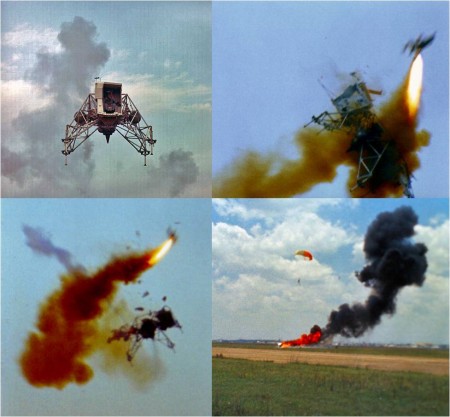
Forty-five years ago today, NASA Astronaut Neil A. Armstrong narrowly escaped with his life when he was forced to eject from the Lunar Landing Research Vehicle in which he was training. Armstrong punched-out only 200 feet above ground level and spent just 4 seconds in the silk before safely landing.
The Lunar Module (LM) was the vehicle used by Apollo astronauts to land on and depart from the lunar surface. This unique spacecraft consisted of separate descent and ascent rocket-powered stages. The powered descent phase was initiated at 50,000 feet AGL and continued all the way to landing. The powered ascent phase lasted from lunar lift-off to 60,000 feet AGL.
It was recognized early in the Apollo Program that landing a spacecraft on the lunar surface under vacuum conditions would be very challenging to say the least. To maximize their chances for doing so safely, Apollo astronauts would need piloting practice prior to a lunar landing mission. And they would need an earth-bound vehicle that flew like the LM to get that practice.
The Lunar Landing Research Vehicle (LLRV) was the answer to the above. The LLRV employed a turbojet engine that provided vertical thrust to cancel five-sixths of its weight since the gravity on the Moon is one-sixth that of Earth. The vehicle was also configured with dual lift rockets to provide vertical and horizontal motion. LLRV 3-axis attitude control was provided by a series of 16 small thrusters.
The LLRV was described by one historical NASA document as being “unconventional, contrary and ugly”. Known as the “Flying Bedstead”, the LLRV was designed for the specific purpose of simulating LM flight during the terminal phase of a lunar landing. The LLRV was not easy to fly in the “low and slow” flight regime in which it operated. The type was not eye-pleasing in the least.
A pair of LLRV’s were constructed by Bell Aerosystems and flight tested at what is now the NASA Dryden Flight Research Center starting in October 1964. These vehicles were subsequently shipped to Ellington Air Force Base in Texas by early 1967. A number of flight crew, including Neil Armstrong, began LLRV flight training shortly thereafter.
Neil Armstrong made his first LLRV flight on Monday, 27 March 1967 in LLRV No. 1. (This occurred two months after the horrific Apollo 1 Fire.) Armstrong continued flight training in the LLRV over the next year in preparation for what would ultimately be the first manned lunar landing attempt in July of 1969
On Monday, 06 May 1968, Armstrong was flying LLRV No. 1 when the vehicle began losing altitude as its lift rockets lost thrust. Using turbojet power, Armstrong was able to get the LLRV to climb. As he did so, the vehicle made an uncommanded pitch-up and roll over. The attitude control system was unresponsive. The pilot had no choice but to eject.
Neil Armstrong ejected from the LLRV at 200 feet AGL as LLRV No. 1 crashed to destruction. The pilot was subjected to an acceleration of 14 G’s as his rocket-powered, vertically-seeking ejection seat functioned as designed. Armstrong got a full chute, but made only a few swings in same before safely touching-down back on terra firma. His only injury was to his tongue, which he accidently bit at the moment of ejection seat rocket motor ignition.
A mishap investigation board attributed the LLRV mishap to a design deficiency that allowed the helium gas pressurant of the lift rocket and attitude control system fuel tanks to be be accidently depleted. Thus, propellants could not be delivered to the lift rockets and attitude control system thrusters.
Neil Armstrong and indeed all of the Apollo astronauts who landed on the Moon trained in improved variants of the LLRV known as the Lunar Landing Training Vehicle (LLTV). This training was absolutely crucial to the success of the half-dozen Apollo crews who landed on the Moon. Indeed, there was no other way to adequately simulate moon landings except by flying the LLTV.
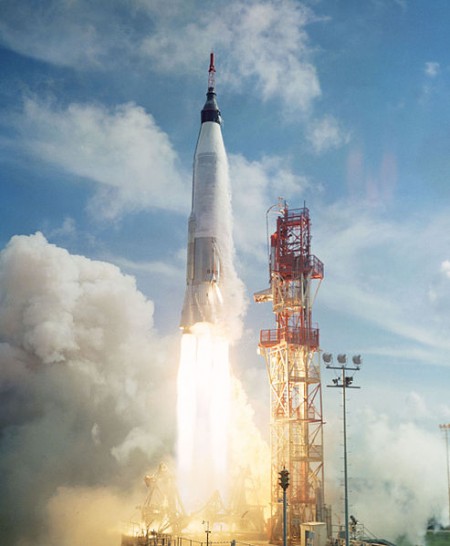
Fifty-two years ago this month, NASA launched Mercury-Atlas 3 (MA-3). While technically a flight test failure, the mission had the unexpected consequence of successfully demonstrating the Mercury spacecraft abort system under realistic emergency flight conditions.
Project Mercury was America’s first manned spaceflight program. Led by the National Aeronautics and Space Administration (NASA), the basic goals of Project Mercury were simple: (1) Orbit a manned spacecraft around the Earth, (2) investigate man’s ability to function in space and (3) recover both man and spacecraft safely.
The guidelines for achieving the above were equally straightforward: (1) Use existing technology and equipment wherever practical, (2) employ the most simple and reliable approach to system design, (3) place the spacecraft into orbit using an existing booster and (4) conduct a progressive and logical test program.
Project Mercury utilized a pair of existing military boosters converted for the manned flight role. The Redstone Intermediate Range Ballistic Missile (IRBM) was used for suborbital missions. Orbital missions were flown using the more powerful Atlas Intercontinental Ballistic Missile (ICBM). Both spacecraft-booster versions were tested a number of times prior to lofting men in to space.
The first suborbital flight test of the Mercury-Atlas combination, Mercury-Atlas 1 (MA-1), was conducted in July of 1960. Unfortunately, the booster structurally failed and exploded about a minute into flight. A second attempt at flying a Mercury-Atlas suborbital mission followed in February of 1961. Things worked out much better this time around as Mercury-Atlas 2 (MA-2) successfully met all test objectives.
The next step in the Mercury-Atlas test series was to attempt at a single orbit mission. This was the primary objective of Mercury-Atlas 3 (MA-3). The subject Mercury spacecraft carried an astronaut simulator intended to mimic the inhalation and exhalation of gas, heat and water vapor characteristics of a man.
On Tuesday, 25 April 1961, Mercury-Atlas 3 lifted-off from Cape Canaveral’s LC-14 at 16:15 UTC. As the vehicle thundered away from the launch pad, all systems functioned as planned. However, the Range Safety Officer (RSO) terminated the mission 43.3 seconds after lift-off as the Atlas launch vehicle began to stray from the intended flight trajectory. The launch vehicle’s autopilot had failed.
Interestingly, the Mercury spacecraft’s abort sensing system and rocket escape system worked exactly as designed. The Mercury spacecraft was safely rocketed away from the exploding booster and lofted to an altitude of 24,000 feet. The parachute recovery system deployed successfully and gently deposited the spacecraft about 4 nm downrange of the launch site. All of this in what was a true in-flight emergency. Had an astronaut been onboard, he would have survived the destruction of the booster.
As a footnote to this story, the Mercury spacecraft flown on MA-3 was found to be in such good condition that it was used for the very next Mercury-Atlas orbital attempt. Happily, that mission, Mercury-Atlas 4 (MA-4) successfully achieved earth orbit and met all flight objectives in September of 1961.
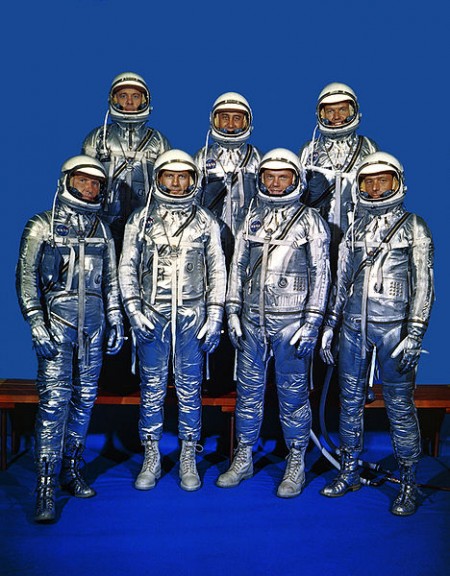
Fifty-four years ago this month, NASA held a press conference in Washington, D.C. to introduce the seven men selected to be Project Mercury Astronauts. They would become known as the Mercury Seven or Original Seven.
Project Mercury was America’s first manned spaceflight program. The overall objective of Project Mercury was very simple: place a manned spacecraft in Earth orbit and bring both man and machine safely back home. Project Mercury ran from 1959 to 1963.
The men who would ultimately become Mercury Astronauts were among a group of 508 military test pilots originally considered by NASA for the new role of astronaut. The group of 508 candidates was then pared to 110, then 69 and finally to 32. These 32 volunteers were then subjected to exhaustive medical and psychological testing.
A total of 18 men were still under consideration for the astronaut role at the conclusion of the demanding test period. Now came the hard part for NASA. Each of the 18 finalists was truly outstanding and would be a worthy finalist. But there were only 7 spots on the team.
On Thursday, 09 April 1959, NASA publicly introduced the Mercury Seven in a special press conference held for this purpose at the Dolley Madison House in Washington, D.C. The men introduced to our nation that day will forever hold the distinction of being the first group of American astronauts. Presented in the order in which they flew, the Mercury Seven were:
Alan Bartlett Shepard Jr., United States Navy. Shepard flew the first Mercury sub-orbital mission (MR-3) on Friday, 05 May 1961. He was also the only Mercury astronaut to walk on the Moon. Shepherd did so as Commander of Apollo 14 (AS-509) in February 1971. Alan Shepard succumbed to leukemia on 21 July 1998 at the age of 74.
Vigil Ivan (“Gus”) Grissom, United States Air Force. Grissom flew the second Mercury sub-orbital mission (MR-4) on Friday, 21 July 1961. He was also Commander of the first Gemini mission (GT-3) in March 1965. Gus Grissom might very well have been the first man to walk on the Moon. But he lost his life in the Apollo 1 Fire, along with Astronauts Edward H. White II and Roger B. Chaffee, on Friday, 27 January 1967. Gus Grissom was 40 at the time of his death.
John Herschel Glenn Jr., United States Marines. Glenn was the first American to orbit the Earth (MA-6) on Thursday, 22 February 1962. He was also the only Mercury Astronaut to fly a Space Shuttle mission. He did so as a member of the STS-95 crew in October of 1998. Glenn was 77 at the time and still holds the distinction of being the oldest person to fly in space. John Glenn will be 92 in July 2013.
Malcolm Scott Carpenter, United States Navy. Carpenter became the second American to orbit the Earth (MA-7) on Thursday, 24 May 1962. This was Carpenter’s only mission in space. He subsequently turned his attention to under-sea exploration and was an aquanaut on the United States Navy SEALAB II project. Scott Carpenter will be 88 in May 2013.
Walter Marty Schirra Jr., United States Navy. Schirra became the third American to orbit the Earth (MA-8) on Wednesday, 03 October 1962. He later served as Commander of Gemini 6A (GT-6) in December 1965 and Apollo 7 (AS-205) in October 1968. Schirra was the only Mercury Astronaut to fly Mercury, Gemini and Apollo orbital spaceflight missions. Wally Schirra suffered a heart attack in May 2007 and passed away at the age of 84.
Leroy Gordon Cooper Jr., United States Air Force. Cooper became the fourth American to orbit the Earth (MA-9) on Wednesday, 15 May 1963. In doing so, he flew the last and longest Mercury mission (22 orbits, 34 hours). Cooper was also Commander of Gemini 5 (GT-5), the first long-duration Gemini mission, in August 1965. Gordo Cooper died from heart failure in October 2004 at the age of 77.
Donald Kent Slayton, United States Air Force. Slayton was the only Mercury Astronaut to not fly a Mercury mission when he was grounded for heart arrythemia in 1962. He subsequently served many years on Gemini and Apollo as head of astronaut selection. He finally got his chance for spaceflight in July 1975 as a crew member of the Apollo-Soyuz mission (ASTP). Deke Slayton died from brain cancer in June of 1993 at the age of 69.
History records that the Mercury Seven was the only group of NASA astronauts that had a member who flew each of America’s manned spacecraft (i.e, Mercury, Gemini, Apollo and Shuttle). Though just men and imperfect mortals, we salute each of them for their genuinely heroic deeds and unique contributions made to the advancement of American manned spaceflight.
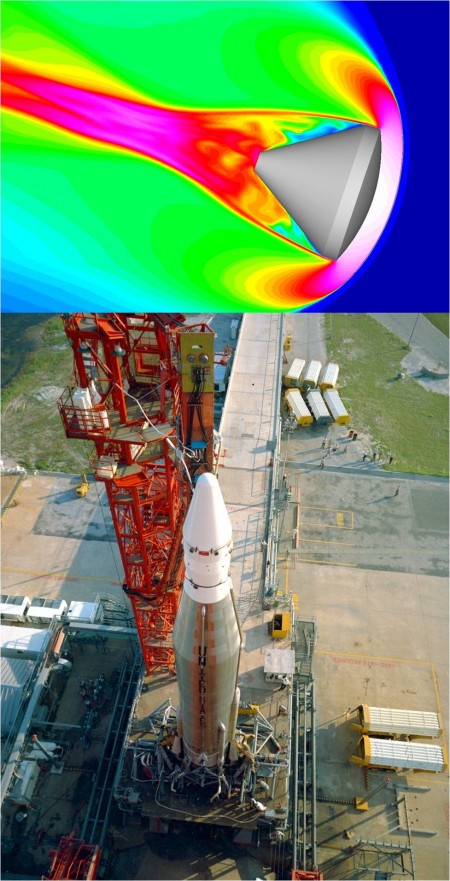
Forty-nine years ago this month, the first of two NASA Project FIRE flights to acquire aerodynamic heating flight data on a subscale Apollo reentry vehicle was successfully flown. The mission provided vital aerothermodynamics data needed by the Apollo Program to evaluate heatshield materials and communications blackout phemomena for superorbital reentry of the Apollo Command Module.
The rapid advancement of manned space exploration in the 1960’s accentuated the need for defining the reentry heating environment at velocities exceeding the earth’s escape velocity. The primary objective of Project FIRE (Flight Investigation of the Reentry Environment) was to obtain convective and radiative aerodynamic heating data for a subscale reentry vehicle representative of the Apollo Command Module.
The Project FIRE concept involved the use of an Atlas D launch vehicle to loft the FIRE spacecraft into a suborbital flight path. During the post-apogee leg of this trajectory, an Antares II solid-fuel upper stage fired and drove the payload to maximum velocity. Instruments within the FIRE spacecraft measured and radioed data to the ground all the way to splash. There was no attempt to recover the payload.
The heating pulse for a FIRE reentry lasted about 40 seconds. However, a single calorimeter could not survive the entire entry heating period. As a solution to this problem, NASA engineers developed an innovative, but complex, 6-layer heat shield to measure the convective and radiative heat flux rates throughout the heating pulse.
The first, third and fifth layers of the FIRE forebody heat shield were made from beryllium and instrumented with thermocouples to obtain reentry temperature-time histories. The second, fourth and sixth layers consisted of phenolic asbestos thermal protection material. The first two of these latter layers were jettisoned at appropriate times during the entry heating pulse to expose a fresh calorimeter to a clean environment.
Radiometers measured total radiant heat flux through quartz windows mounted in each forebody layer. One each was located in the stagnation region and near corner of the front face of the base heat shield. The short life of these radiometer quartz windows limited acquisition of radiant heat flux data to three brief periods during the heating pulse.
On Tuesday, 14 April 1964, an Atlas D launch vehicle carrying the FIRE 1 spacecraft lifted-off from Cape Canaveral’s LC-12 at 21:42:25 UTC. A ballistic trajectory was flown down the Eastern Test Range (ETR). The maximum velocity and flight path angle achieved during the mission was 37,790 feet per second and -14.5 degrees, respectively. Payload impact occurred in the South Atlantic Ocean near Ascension Island. Total flight time from launch to splash was on the order of 32 minutes.
From a trajectory and sequence-of-events standpoint, FIRE 1 was a complete susccess, since the vehicle performance and timed events were well within prescribed limits. However, a faulty telemetry antenna and unexpectedly large coning motions of the FIRE spacecraft complicated data acquisition and interpretation.
Maximum flight-measured heating rate on the FIRE spacecraft forebody was 1,003 BTU’s per square foot per second, which agreed well with ground test and theory. Incredibly, the spacecraft exterior reached an estimated temperature of 20,000 degrees Fahrenheit; hotter than the outer surface of the Sun.

Forty-nine years ago today, NASA successfully conducted the orbital mission of Gemini-Titan 1. The unmanned test marked the first time that a modified Titan II ICBM launch vehicle was used to loft a Gemini spacecraft into earth orbit.
Project Mercury was America’s first manned spaceflight series. Project Apollo would ultimately land men on the Moon and return them safely to the Earth. In between these historic spaceflight efforts would be Project Gemini.
The purpose of Project Gemini was to develop and flight-prove a myriad of technologies that were required to get to the Moon. Those critical technologies included spacecraft power systems, rendezvous and docking, orbital maneuvering, long duration spaceflight and extravehicular activity.
Gemini-Titan 1 (GT-1) was the first flight of the Gemini Program. The primary goals of the mission were to (1) verify the structural integrity of the Gemini spacecraft-Titan II booster combination, (2) exercise the program’s new tracking and communication systems, and (3) provide realistic training for Gemini ground support crews.
The Gemini I spacecraft did not carry a crew. Thus, it was not configured with a life support system nor crew seats . Rather, the vehicle carried equipment for measuring flight pressure, vibration, acceleration, temperature, and structural loads data. These test measurements were telemetered to the ground during the flight for later analysis.
The Titan II was designed as an Intercontinental Ballistic Missile (ICBM). In its new role as a manned launch vehicle, the Titan II’s reliability had to be improved substantially before commiting a human crew to flight. Like the Redstone and Atlas missiles converted for the manned launcher role in the Mercury Program, this demanding task would be successfully completed in the case of the Titan II as well.
On Wednesday, 08 April 1964, Gemini-Titan 1 lifted-off at 16:01:01.69 UTC from Cape Canaveral’s LC-19. It only took about 330 seconds for the Gemini spacecraft to be inserted into an elliptical orbit measuring 165 nm (apogee) by 87 nm (perigee). The Titan second stage would remain attached to the Gemini spacecraft throughout the mission.
The GT-1 mission was officially completed after three (3) earth orbits encompassing slightly under 5 hours of flight. However, the combined spacecraft-second stage configuration remained in space for 95 hours before reentering the earth’s atmosphere during orbit 64. By design, the vehicle did not survive the fiery reentry. Debris impact occurred in the South Atlantic around 15:00 UTC on Sunday, 12 April 1964.
Although certainly not problem free, Gemini-Titan 1 successfully satisfied mission objectives and provided confidence in both the Gemini spacecraft and the Titan II booster. Another successful unmanned mission (GT-2) would follow in January 1965. The technical know-how gleaned from these early unmanned flights led to the first manned Gemini mission (GT-3) which was successfully flown in March 1965.
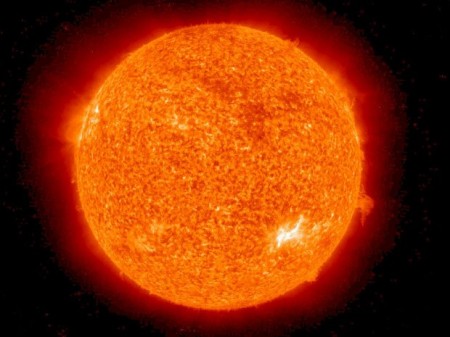
Washington DC, 01 April 2013 – In a bold new initiative intended to revitalize a flagging American human spaceflight program, government officials today announced plans to land a team of astronauts on the Sun by the year 2038.
The stunning announcement immediately evoked comparisons to the glory days of the Apollo lunar landing effort. Public reaction to this next great adventure in space was overwhelmingly favorable. However, talk of a resurgence in American space supremacy failed to sway federal lawmakers whose collective response could best be described as tepid.
Responding to claims in some sectors that the benefit-to-risk ratio is far too low for such a mission, the space agency immediately countered that unusually extreme measures are being taken to mitigate mission risk. Reportedly, a key element of the risk mitigation plan involves scheduling the solar landing at night. Moreover, each astronaut will be equipped with a personal fire extinguisher and also receive the equivalent of a masters degree in fire science by way of pre-flight training.
Crew creature comforts are also a high priority for the solar landing mission. Citing as proof that the space agency has done their homework here as well, officials indicated that the landing party will be provided with more than ample supplies of sunscreen (SPF 1 Million), sun glasses (welder’s glass), and asbestos undergarments.
Amidst a flurry of early speculation regarding the prime crew for the first solar landing attempt, the most frequently mentioned names are those of Gollum, Cruella De Vil, and Count Rugen. Back-up crew members include the Wicked Witch of the North, the Joker, and a player to be named later. While space officials declined to provide details, the competition for a seat on this daring mission is understandably intense.
It is not obvious at this writing as to how the solar landing team will actually get to the Sun. The United States (1) has not flown a Saturn V launch vehicle since 1973, (2) retired the Space Shuttle in 2011, (3) currently has no manned-rated launch system, and (4) must rely on Russia to get to and from its own space station. However, a senior space official requesting anonymity avers that alien abduction is a leading contender for transport to the Sun.
Challenging too is the question of how astronauts will travel on the surface of the Sun where temperatures are on the order of 10,000F. A possible solution to this vexing problem comes by way of the automobile industry which has suggested the use of an all-electric version of the Chevy Volt. Government officials have been swift to agree. Not only is there a reduction of fire and explosion hazard due to elimination of combustible fuels, but there is the additional benefit of taking the green movement to the Sun.
One simplifying feature of the solar landing mission is that there is no return flight. Thus, the technical complexities and substantial costs associated with lift-off from the Sun, trans-earth trajectory, and atmospheric entry back at Earth are eliminated. Environmentalists were especially pleased to hear that entry vehicle aerodynamic heating would not be a factor on this mission. The fear being that such heating would markedly contribute to man-made global warming or whatever the climate change crisis du jour.
That’s our report for now. Suffice it to say that uncommon days lie ahead for the American human spaceflight program. To stay abreast of the latest solar landing project developments, the interested reader is directed to the following URL: AprilFool.com
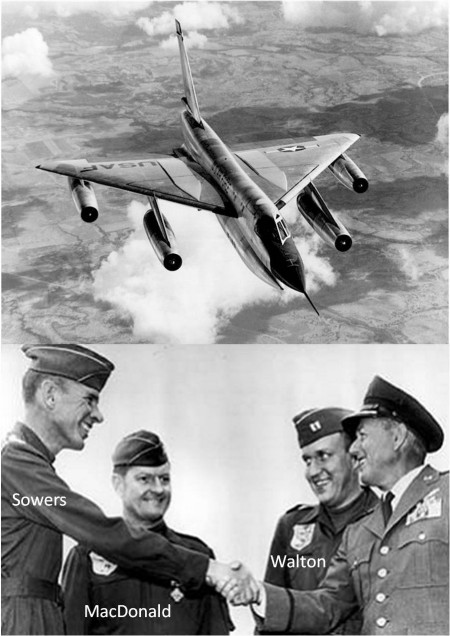
Fifty-one years ago this month, a USAF/Convair B-58A Hustler from the 43rd Bomb Wing at Carswell AFB, Texas set a trio of transcontinental speed records in a round trip from Los Angeles to New York and back. This historic feat was accomplished as part of Operation Heat Rise.
The USAF/Convair B-58A Hustler holds the distinction of being the world’s first supersonic bomber. A product of the 1950’s, the delta-winged aircraft measured 96.8 feet in length and had a wing span of 56.8 feet. GTOW stood around 163,000 lbs. Power was provided by a quartet of General Electric 79 turbojets which produced 62,000 lbs of sea level thrust in afterburner.
The Hustler’s performance was impressive then and now. With a maximum speed of 1,325 mph, the aircraft had a service ceiling of 64,800 feet and a combat radius of 1,520 nm. The Hustler’s mission range could be markedly increased via aerial refueling.
The B-58’s three man air crew sat in tandem in the order of pilot, navigator and Defensive Systems Officer (DSO). Each man occupied a separate flight station which was equipped with an ejection pod for protection during high speed egress.
The Hustler was part of Strategic Air Command. It’s primary mission was delivery of nuclear weapons. The aircraft served in the air force’s operational inventory for a period of just 10 years years (1960 to 1970). A total of 116 airframes were produced and none were used in anger.
The Hustler’s high speed capability led to the type being used to establish numerous speed records during its operational life. Operation Heat Rise was one such effort. The goal of this project was to establish segmental and overall speed records for a round trip flight between the west and east coasts of the United States.
On Monday , 05 March 1962, the crew of Major Robert G. Sowers (pilot), Captain Robert MacDonald (navigator) and Captain John T. Walton (DSO) departed Carswell AFB, Texas in B-58A S/N 59-2458. Other than a new wax job, the aircraft was no different than the other Hustler airframes in the inventory.
After refueling out over the Pacific Ocean, the aircraft started its coast-to-coast speed run at Mach 2 over Los Angeles, California. Incredibly, the critical ground station monitoring the start time did not record passage of the aircraft overhead. Thus, airplane and crew were called back for a restart! This meant another trip to the tanker out over the Pacific to top off the Hustler’s fuel tanks prior to the second try.
Once officially underway, the trip from overhead Los Angeles to overhead New York took 2 hours and 58.71 seconds for an average speed of 1,214.65 mph. The aircraft was refueled over Kansas on its way east. Once out over the Atlantic Ocean, the Hustler reversed course and hit the tanker again.
The return trip from overhead New York to overhead Los Angeles was flown in 2 hours, 15 minutes and 50.08 seconds. As on the eastbound leg, the Hustler took on a load of gas over Kansas. The entire round trip required 4 hours, 41 minutes and 14.98 seconds inclusive of refueling. Each of the aforementioned trip times established new performance records.
An interesting aspect of the return leg to Los Angeles was that the Hustler flew faster than the rotational movement of the earth. Thus, the aircraft and its crew arrived in California roughly 41 minutes earlier than the sun!
After landing in Los Angeles, the crew was enthusiastically greeted by members of the air force, the aerospace industry and the media. In recognition of their accomplishments, each man received the USAF Distinguished Flying Cross at the hand of USAF General Thomas S. Power, Chief of Staff.
Finally, for their impressive performance during Operation Heat Rise, crew and aircraft were the recipients of both the 1962 MacKay and Bendix Trophies. This marked the last time that the latter was ever awarded.











